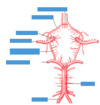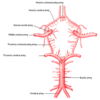Anatomy of blood flow in the CNS and consequences of disruption Flashcards
What proportion of body weight does the brain make up?
2%
What proportion of cardiac output does the brain use?
10-20%
What proportion of body oxygen consumption is the brain responsible for?
20%
What proportion of liver glucose does the brain use?
66%
What are the sources of blood supply to the brain?
Internal carotid arteries
Vertebral arteries
Circle of Willis
Cerebral arteries
Label the following diagram:


What is the advantage of the anterior and posterior communicating arteries in the circle of Willis?
Compensatory blood flow from contralateral internal carotid artery if one is occluded, e.g. in stroke.
Describe venous drainage of the brain.
Cerebral veins within brain.
No veins in cranial cavity.
Venous sinuses- folds of dura mater, drain towards confluence in sinuses (back of head), down into the neck towards the internal jugular vein.
Which artery of the circle of Willis is unpaired?
Anterior communicating artery
What is a stroke?
Cerebrovascular accident (CVA).
Rapidly developing focal disturbance of brain function of presumed vascular origin and of >24 hours duration.
Infarction (85%) or haemorrhage (15%).
What is a transient ischaemic attack (TIA)?
Rapidly developing focal disturbance of brain function of presumed vascular origin that resolves completely within 24 hours.
What is infarction?
Degenerative changes which occur in tissue following occlusion of an artery.
What is cerebral ischaemia?
Lack of sufficient blood supply to nervous tissue resulting in permanent damage if blood flow is not restored quickly.
What is thrombosis?
Formation of a blood clot (thrombus).
What is embolism?
Plugging of a small vessel by material carried from larger vessel, e.g. thrombi from the heart or atherosclerotic debris from the internal carotid.






